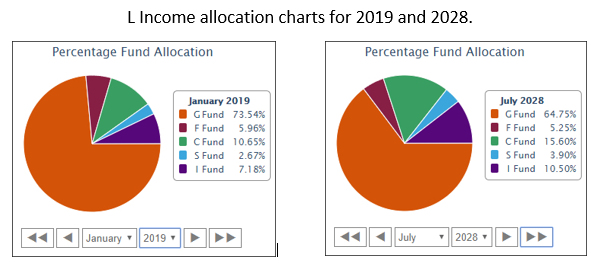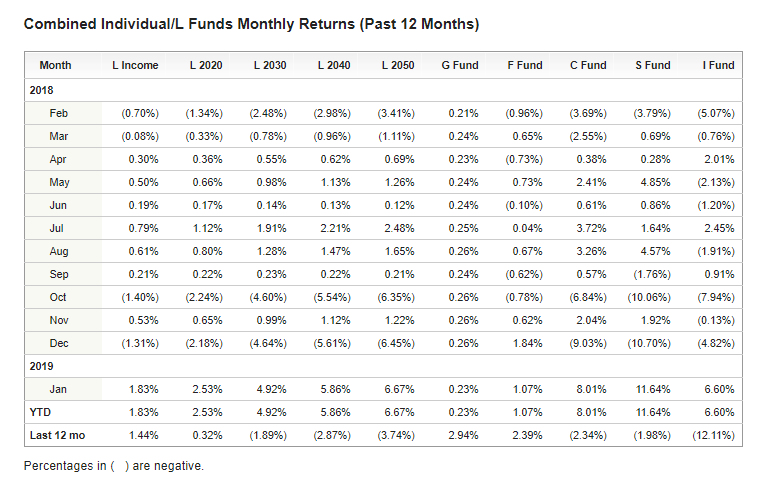Posted on Monday, 4th March 2019 by Dennis Damp
 Print This Post
Print This Post
The TSP currently requires that you make a full withdrawal election after you turn 70½ if you haven’t initiated any of the withdrawal options and have separated from federal service. If you fail to do that, the TSP initiates an account “abandonment” process. Fortunately, the new law passed in late 2017 establishes more flexible withdrawal options and does away with this requirement. You won’t be required to make a full withdrawal election when the new law is implemented in September of 2019. You will be required to take a Required Minimum Distribution (RMD) starting at age 70 ½.

Request a Federal Retirement Report™ today to review your projected annuity payments, income verses expenses, FEGLI, and TSP projections.
Under the new rules, when implemented, you can satisfy the RMD requirement by taking a partial withdrawal or installment payments. If you take no action or just don’t withdraw enough to meet your RMD, the TSP will automatically send you the remaining RMD amount.
If your account has already been abandoned, you’ll be able to restore the account without making a full withdrawal election. Your restored balance can remain in the plan (subject to RMDs) with all the new withdrawal options available.
These changes are good news for everyone and especially for retirees that wish to keep their funds in the TSP when they reach age 70 ½. The new withdrawal options fall into the following categories:
- Multiple age-based (for those 59½ or older) in service and post-separation partial withdrawals will be allowed.
- You’ll be able to choose whether your withdrawal should come from your Roth balance, your traditional balance, or a proportional mix of both.
- You will no longer be required to make a full withdrawal election after you turn 70½ and are separated. (You will still need to receive IRS required minimum distributions (RMDs).
- If you’re a separated participant, in addition to the option of monthly payments, you’ll be able to choose quarterly or annual payments, and you’ll be able stop, start, or make changes to your installment payments at any time.
Many, like myself, that will soon turn 70 or have recently reached that milestone need to know what steps to take to remain in the TSP when the deadline for withdrawing our account arrives.
I talked with Rob, a customer service representative at the TSP. He advised me that the rules will change this September as reported to accommodate RMD distributions. If you will be age 70 ½ this year and do nothing, the TSP will automatically send out your first RMD next March for 2019. For all subsequent years your RMD will be sent to you in December. If you do nothing this year and let the TSP send you the automatic payment next March you will receive two RMDs in 2020, one in March for your 2019 RMD and the second will arrive in December for 2020. This could increase your income sufficiently to cause your Medicare Part B premiums to increase.
To avoid receiving two payments in one year, you can take a partial withdrawal this year for the amount of your RMD using their TSP 77 form. This form can be filled out online, just sign on to your TSP account and search for this form. You can also request a copy by calling the TSP at 1-877-968-3778. Rob assured me that the partial withdrawal would be counted as your first RMD and the TSP won’t send a duplicate payment in March. They will automatically send your next RMD in December of 2020, and each year thereafter.
If you withdraw an insufficient amount from your TSP account to cover your RMD the penalties are severe, 50% of the shortfall plus the income tax owed. You will also have to add your distribution to your federal tax return and pay taxes on them. Your RMD distribution is taxed as ordinary income. To determine the amount of your RMD according to Kiplinger’s, “divide your year-end account balance from the previous year by the IRS life-expectancy factor based on your birthday in your current year.” Use the tables in IRS Publication 590-B to determine your life-expectancy factor. Kiplinger’s also has an online 2019 RMD calculator that you can use. I called the TSP and had them calculate my RMD to determine how much I needed to request for my partial withdrawal.
A word of caution for those who have Medicare B coverage, your Modified Adjusted Gross Income (MAGI), may increase as reported on your IRS tax return. You may have to pay the standard Medicare B premium amount and an Income Related Monthly Adjustment Amount (IRMAA). This extra charge is added to your Medicare Part B premium based on your income. Another factor kicks in for those who decided to hold off collecting their Social Security until age 70. The added Social Security income along with the RMD distribution can easily increase your Medicare part B premium significantly.
The main advantages of the TSP system are their extremely low managements fees, averaging $0.40 per $1,000 invested in 2018 or .04%. It would be difficult finding funds outside of the TSP paying fees this low, however some index funds are close to this figure today. Expense ratios may also be expressed in basis points. One basis point is 1/100th of one percent, or .01%. Therefore, the 2018 TSP net expense ratio of .04 % is 4.0 basis points.
You also have the advantage of investing in their diversified portfolio of funds including one that is guaranteed to never decrease in value, the Government Securities Investment (G Fund). The G Fund offers the opportunity to earn rates of interest similar to those of U.S. government notes and bonds but without any risk of loss of principal and very little volatility of earnings.
The G Fund’s investment objective is to produce a rate of return that is higher than inflation while avoiding exposure to credit (default) risk and market price fluctuations. It is one of the only funds that is guaranteed to never decrease in value. The G Fund interest rate calculation is based on the weighted average yield of all outstanding Treasury notes and bonds with 4 or more years to maturity. As a result, participants who invest in the G Fund are rewarded with a long-term rate on what is essentially a short-term security. Generally, long-term interest rates are higher than short-term rates.
There are many funds to choose from including their Life Cycle Funds that provide hands free investing for those targeting a specific retirement date.
Before leaving the TSP evaluate your options. Here is a list of articles and resources that you may find helpful when considering leaving the Thrift Savings Plan.
- TSP Considerations – What to do with your TSP after you retire
- The TSP Advantage (Should I Stay or Go)
- Survivor’s Beware – The TSP Trap
- TSP FACT Sheet (New Withdrawal Options)
Request a Federal Retirement Report™ today to review your projected annuity payments, income verses expenses, FEGLI, and TSP projections
Helpful Retirement Planning Tools / Resources
- TSP Information
- Financial Planning Guide
- Retirement Planning Guide
- Budget Work Sheet
- Master Retiree Contact List (Important contact numbers and information)
- 2019 Leave and Schedule Chart (Excel chart tracks all leave balances. Use this chart to set target retirement dates.)
- Annuity Calculator (FREE Excel chart estimates annuity growth)
Disclaimer:Opinions expressed herein by the author are not an investment or benefit recommendation and are not meant to be relied upon in investment or benefit decisions. The author is not acting in an investment, tax, legal, benefit, or any other advisory capacity. This is not an investment or benefit research report. The author’s opinions expressed herein address only select aspects of various federal benefits and potential investment in securities of the TSP and companies mentioned and cannot be a substitute for comprehensive investment analysis. Any analysis presented herein is illustrative in nature, limited in scope, based on an incomplete set of information, and has limitations to its accuracy. The author recommends that retirees, potential and existing investors conduct thorough investment and benefit research of their own, including detailed review of OPM guidance for benefit issues and for investments the companies’ SEC filings, and consult a qualified investment adviser. The information upon which this material is based was obtained from sources believed to be reliable, but has not been independently verified. Therefore, the author cannot guarantee its accuracy. Any opinions or estimates constitute the author’s best judgment as of the date of publication, and are subject to change without notice. The author explicitly disclaims any liability that may arise from the use of this material.
Posted in BENEFITS / INSURANCE, ESTATE PLANNING, FINANCE / TIP, RETIREMENT CONCERNS, SOCIAL SECURITY / MEDICARE, SURVIVOR INFORMATION
Comments (0)|  Print This Post
Print This Post








